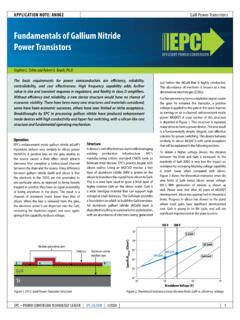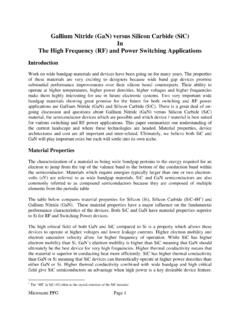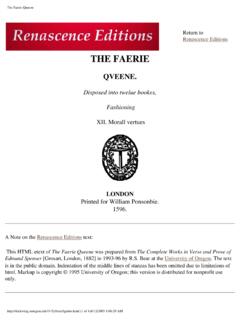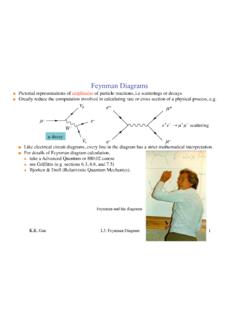Transcription of 7. Kinetic Energy and Work Kinetic Energy
1 7. Kinetic Energy and WorkKinetic Energy :The Kinetic Energy of a moving object: k=12mv2 Kinetic Energy is proportional to the squareof the velocity. If the velocity of an object doubles, the Kinetic Energy increases by a factor of four. Kinetic Energy is proportional to the mass. If a bowling ball and a ping pong ball have the same velocity, the bowling ball has much larger Kinetic Energy . Kinetic Energy is always positive. unit : Joule (J) =kg m2/s2 Example:If we drop a 3-kg ball from a height of h = 10 m,the velocity when the ball hits the ground isgiven by:v2=v02+2a(y y0) =0 2g(0 h)v=2gh =2( m/s2)(10 m) =14 m/sInitial: k=12mv2=0 Final: k=12mv2 =12(3 kg)(14 m/s)2 =294 JSo as the ball falls, its Kinetic Energy increases.
2 Itis the gravitational force that accelerates the ball,causing the speed to increase. The increase inspeed also increases the Kinetic Energy . Theprocess of a force changing the Kinetic Energy ofan object is called :Work is the Energy transferred to or from anobject by mean of a force acting on the object. Energy transferred to an object is positive work, gravity performs positive work on afalling ball by transferring Energy to the ball,causing the ball to speed up. Energy transferred from an object is negativework, gravity performs negative work on aball tossed up by transferring Energy from theball, causing the ball to slow down.
3 Both Kinetic Energy and work are scalars. unit: JWork Energy Theorem:The work done is equal to the change in thekinetic Energy : K=Kf Ki=WIn the above example with the ball falling from aheight of h = 10 m, the work done by gravity:W= k=kf ki=294 J 0J=294 a ball rises to a height of h =10 m, the workdone by gravity:W= k=kf ki=0J 294 J= 294 Done by a Force:Consider a box being dragged a distance d acrossa frictionless floor:dFyx v2=v02+2ax(x x0)v2=v02+2axd12mv2=12mv02+maxd12mv2 12mv02=maxdkf ki=(Fcos )d W=(Fcos )d is the angle between the force vector and the direction of motion.
4 If the force is perpendicular to the direction ofmotion, then the work done:W=(Fcos )d=Fdcos90 =Fd 0=0. The work Energy theorem and the relationship between work and force are valid only if the force does not cause any other form of Energy to change, e. g. we can not apply the theorem when friction is involved because it causes a change in the thermal Energy (temperature).Work Done by Multiple Forces:The total work done by many forces acting onan object: Wtot=F1cos 1d+F2cos 2d+F3cos 3d+Lwhere the angles are the angle between eachforce and the direction of motion.
5 The total workis just the sum of individual work from eachforce: Wtot=W1+W2+W3+LThe work Energy theorem relates the changes inthe Kinetic Energy to the total work performed onthe object: K=WtotExample:A 3-kg box initially at rest slides 3 m down africtionless 30 incline. What is the work done onthe object? What is the Kinetic Energy and speedat the bottom?xyN mg The work done is performed by the force inthe x direction since there is no motion in the ydirection:W=Fxd=(mgsin )d=(3 kg)( m/s2)(sin30 )(3 m)=44 JAlternatively,W=(Fcos )d=Fcos(90 )d=Fsin d HThe first method of using the component of the force in the direction of motion for thecalculation is ki=kf 0kf=W=44 JW=12mv2v2=2 Wmv=2Wm=2 44 J3 kg= m/sHcalculate the speed without using the equation of Question:A 1-kg ball on a string is moving in uniformcircular motion.
6 The tension is providing thecentripetal force on the ball. In one revolution,the work done by the tension on the ball is:a) 2 rTb) 2 rTc) 2 rTcos Problem 15 (p150):A 12-m long fire hose is uncoiled by pulling thenozzle end horizontally along a frictionlesssurface at the steady speed of m/s. The massof m of hose is kg. How much work hasbeen done on the hose by the applied force whenthe entire hose is moving? Hdifficult to solve the problem by calculating the applied force that causes the front end ofthe hose to move a large distance (12 m) whilethe other end has not moved very far use work Energy theoremm= length (mass per unit length)=12 m m=3 kgW=kf ki=12mv2 0=12(3 kg)( m/s)2= JWork done by Gravity:Ball traveling up:vmg Work done by gravity is negative because gravity and the direction of motion are in opposite direction.
7 Consistent with the decrease in Kinetic Energy because the ball is slowing down:Wg= K=Kf Ki=12mvf2 12mvi2<0 Ball traveling down:vmg Work done by gravity is positive because gravity and the direction of motion are in samedirection. consistent with the increase in Kinetic energybecause the ball is speeding up:Wg= K=Kf Ki=12mvf2 12mvi2>0 Question:What is the total work done on a ball that isbeing pulled up a distance d with constant speedusing a string?Tmgv`F =T mg=ma=0T=mgWg= mgdWT=Td=mgdWtot=Wg+WT= mgd+mgd=0 k=Wtot=0 consistent with the fact that the ball is being pulled up with constant :A 10-kg crate initially at rest is being lowereddown a frictionless 10-m ramp using a rope.
8 Thespeed of the crate is 3 m/s at the bottom of the40 ramp. Determine (a) the work done bygravity, (b) the work done by the rope, and (c)the tension in the 10 m(a) Wg=mgsin d =630 J(b) Wtot=Wg+WT= K mgsin d+WT=12mv2 12mv02 WT=12mv2 mgsin d = 585 J(c) WT= Td T= WTd = NSpring Force and Work:xx= 00 When a spring is in a relaxed state, neithercompressed nor stretched, it applied no force tothe attached 00 When a spring is compressed, the spring pushesthe object back toward the relaxed +x= 00 FsWhen a spring is stretched, the spring pulled theobject back toward the relaxed 's Law:The magnitude of the restoring force of a springis proportional to the distance from the relaxedposition:F= kxwhere k is the spring constant.
9 The direction of the spring force is always toward the "relaxed" or equilibrium position, this is a restoring force. The force is not constant: increases linearly with displacement. Hooke's law applies when the spring is not compressed or stretched too far, the spring should not be deformed. Unit of k: Done By a Spring:Since the force is not constant, we must performan integral to determine the work: The workdone by the spring when moving a smalldistance dx:dW=Fdx= kxdxThe total work done in moving from position xito xf :W= kxdx=12xixf kxi2 12kxf2 Example:A 3-kg mass is dropped from a height h = 5 mabove a platform with a spring of spring constantk = 500 N/m.
10 What is the maximum distance thespring will compress?hxmax0vm/s= 0 The total work done on the box must be zerobecause the box is at rest at the beginning andat the end when the spring is compressed: W=Wg+Ws= K=Kf Ki=0Wg= Wsmg(h+xmax)= (12kxi2 12kxf2)mg(h+xmax)=12kxmax212kxmax2 mgxmax mgh=012 500 xmax2 3 xmax 3 5=0250xmax2 30xmax 150=0xmax= m or mPower:Consider a box being dragged up a ramp. Thework done is: W=Fcos dWhether the box is dragged quickly or slowly upthe ramp, the work done is the same.
















